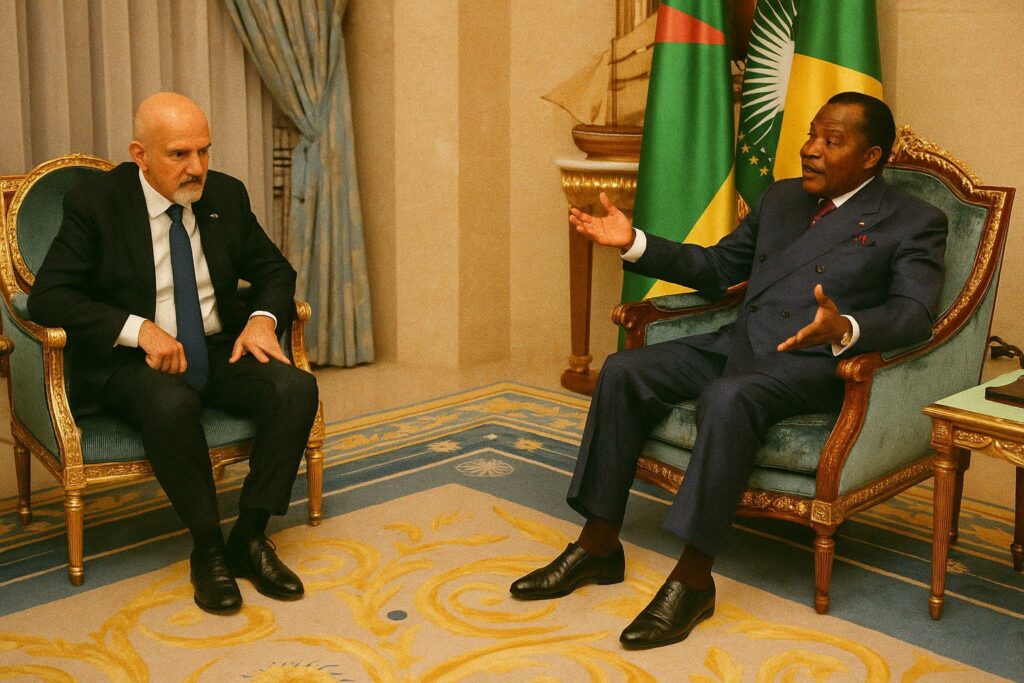Strategic Grid Rehabilitation Begins
When Claudio Descalzi, the long-time chief executive of Eni, emerged from an audience with President Denis Sassou Nguesso this week, he confirmed that technicians had already set foot along the 600-kilometre Brazzaville–Pointe-Noire transmission axis. Dormant pylons dating back to the early 1990s are being reinforced, insulators replaced and digital monitoring devices added to bring the corridor in line with contemporary reliability standards. Government planners underline that once the 225 kV circuit is fully rehabilitated, the Djeno gas-to-power complex will be able to dispatch up to 300 MW toward the capital without the voltage drops that have periodically darkened administrative districts (Ministry of Energy, 2023).
A Calculated Partnership With Brazzaville
Unlike episodic engineering contracts, the present undertaking sits at the heart of a long-range cooperation protocol signed in Oyo in 2021, whereby Eni pledged to channel technical know-how and concessional financing toward backbone energy infrastructure. Officials in the Presidency stress that the arrangement dovetails with the Development Plan 2022-2026, whose energy chapter prioritises domestic value addition before export. By shouldering the grid upgrade, Eni ensures that incremental gas produced from its Marine XII block can be evacuated efficiently, while the state secures affordable electrons for industrial zones near Kintélé and Ignié. Diplomatic observers note that the formula mirrors energy compacts advanced by the International Energy Agency to align investor margins with host-country electrification targets (IEA, 2022).
Gas Monetisation Meets Domestic Demand
Beyond the steel lattice of pylons, the Italian major is accelerating the second phase of its natural gas plan. After inaugurating the Congo LNG project last year, the company now aims to raise liquefaction throughput to 4.5 billion cubic metres annually. The challenge, Descalzi conceded in Brazzaville, is to balance export commitments with domestic draw-off, particularly for the dual-fuel thermal plant at Djeno. The Ministry of Hydrocarbons indicates that roughly 30 percent of associated gas once flared offshore is now re-compressed and sent ashore, a figure that could surpass 60 percent by 2026 if pipeline bottlenecks are resolved (African Energy Chamber, 2023). For Congolese policy-makers, the calculus is straightforward: reliable gas feedstock curbs expensive diesel imports and anchors tariff stability for households.
Biofuel Ambitions in the Bouenza
Electricity is only one vector of the evolving Eni–Congo nexus. In the fertile valleys of Bouenza, the company recently commissioned a seed-crushing facility capable of processing 50 000 tonnes of castor and croton annually into advanced feedstock for bio-refineries in Venice and Gela. Government agronomists underscore that the crops are cultivated on non-food marginal land, insulating staple production while generating rural income. The Italian Agency for Development Cooperation estimates that direct employment could top 3 000 seasonal workers by the next harvest cycle. Observers at the African Development Bank describe the scheme as a textbook illustration of vertical integration: from field to fuel, surplus electricity from the rehabilitated grid will power cold-storage and irrigation pumps, creating a self-reinforcing rural economy (AfDB, 2023).
Macroeconomic and Regional Reverberations
Fiscal projections released by the Ministry of Finance attribute nearly one percentage point of 2024 GDP growth to the combined impact of the grid overhaul and associated gas exports. While the hydrocarbon sector remains the locomotive of foreign-exchange earnings, improved transmission reliability is expected to stimulate light manufacturing clusters around Brazzaville, easing the economy’s hydrocarbon dependence in the medium term. Regionally, enhanced capacity could allow Congo to participate in the Central African Power Pool, sending surplus wattage toward Kinshasa or Bangui during peak hydrological stress on the Congo River dams. Such cross-border flows would not only monetise idle capacity but also fortify Brazzaville’s diplomatic capital within ECCAS, analysts at the Institute for Security Studies argue (ISS, 2023).
A Calculus of Stability and Sustainable Growth
In diplomatic circles, the timing of Eni’s announcement is interpreted as a tangible endorsement of President Sassou Nguesso’s strategy of pragmatic diversification. By entwining upstream gas, downstream power and agro-industrial innovation, Brazzaville projects an image of policy coherence attractive to investors navigating a volatile global energy landscape. The rehabilitation of the high-voltage backbone, though technical in appearance, therefore occupies a symbolic tier: it signals that infrastructure once deemed anachronistic can be re-tooled to serve twenty-first-century climate and development goals. As the first pylons are lifted back into alignment along the lush Mayombe corridor, the message resonates from embassy briefings to boardrooms in Milan: the Republic of Congo is wiring its future with an eye on stability, self-sufficiency and regional stature.

